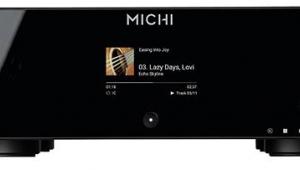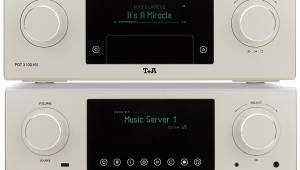Metronome Technologie Kalista Integrated (£29,950)
With its design team headed up by Dominique Giner, Metronome Technologie is a French high-end audio company founded in 1987. Alongside world famous hi-fi marques such as Koetsu, Audio Research, Krell Industries and Sonus faber, Metronome’s products are imported and distributed in the UK by Absolute Sounds of south-west London.
Recent visitors to hi-fi shows at Heathrow may have come across Metronome’s magnificent Kalista Reference CD transport with matching C2A two-box DAC making sublime music in one of Absolute Sounds’ ‘Absolute Studio’ demonstrations, partnered with DarTZeel amplification and Magico speakers. While Metronome produces some slightly more ‘real world’ CD spinners such as the CD3 Signature (a mere £6900 for the transport), the Kalista line-up represents Metronome’s no-holds-barred statement products. Cost no object. They are, without doubt, striking works of art – and they’re a two-man lift.
Before you read further, we’d better talk prices. In case you dream of owning components as fabulously luxurious as Krell, for example... well, Metronome’s Kalista products are to Krell what a Maybach is to an S-Class Mercedes. And if your idea of choosing some new clothes is a trip to M&S rather than recalling the personal number of Stella McCartney from your mobile phone’s memory, you might care to turn the page right now. The Kalista model I’ve been enjoying at home these past couple of weeks is the brand new Kalista Integrated. It’s the cheapest model in Metronome’s Kalista range. It costs £29,950.
The Integrated, then, is the latest addition to Metronome Technologie’s top-end Kalista line-up, and the first integrated Kalista player. It joins the existing Kalista and Kalista Reference CD transports, priced at £20,500 and £29,500 respectively, to which one would add the aforementioned two-box D-toA converter, the £15,500 C2A. Wow!
But just look at our photos. And check out some further images at www.metronome-technologie.com. When I consider that this masterpiece of audio sculpture actually costs more than the two cars parked outside my house, I shudder at the realisation that I really should have contacted my insurers prior to installing it in my listening room.
THE ART OF SCIENCE
With its sculpted acrylic structure similar to that of the existing Kalista transports, the new Integrated commands the attention of anyone entering your listening room, as I discovered on several occasions. Perhaps I should have been photographing the looks of awe on visitors’ faces when they first saw it. Without doubt the blue light which bathes a CD’s surface as it spins atop the player – to improve reading accuracy, claims Metronome – adds to the distinction of the overall design. I didn’t bother pointing out to any of my guests that they were looking at only half the story. The separate power supply feeding the Integrated was on the bottom shelf of my Townshend Seismic Stand, itself the size of a substantial power amplifier with a metal fascia hewn from solid alloy.
Both the supply and the main unit should be sited on the inverted cones supplied with the player. These are fabricated from Delrin, a polymer thermoplastic developed by DuPont that, like Corian, is often described as ‘synthetic stone’. The disc clamp/puck looks like Perspex but is also fabricated from Delrin and it looks and feels fabulous. Less well considered in my opinion is the player’s cover. As all the Kalista models are manual top-loaders, you can’t leave the player unattended without a CD sitting in place otherwise dust will fall onto the critical pickup lens. The black ‘helmet’ cover for parking over the mechanism when not in use seems a bit of an afterthought. At this price I’d like a motorised lid, frankly.
Still, it’s a deliciously pleasing player to use on a daily basis. Reading of a CD’s table of contents is rapid, track access is near-instantaneous, and the Kalista’s remote controller is a reassuringly solid hunk of metal. (Shame the buttons aren’t illuminated, though.) Only one thing really bugged me: there is no method of ‘fast-forwarding’ or reversing through tracks. Both on the player and on the handset, the skip forward and skip back buttons are just that; you can’t hold down the skip buttons in order to fast-scan within long tracks... which might drive you bonkers if you sometimes like to access the last few minutes of a long piece of music. Methinks the designers intend that you should relax and listen to the whole piece, not just the canon or the tubular bells of the finale!
GALLIC HIGH-END ESOTERICA
What is it about French audio designers, I wonder? I was listening recently to the French-designed Cairn Tornado 192 CD player and I swear this Metronome has a similar trait about it, inasmuch as it draws one into the music no matter what flavour. It seems to dig deeply into the spirit of the musical event making one forget about the hi-fi and get on with the business of enjoying the music.
Some hi-fi products – CD players, especially, I find – can sound wonderful one minute (with a pristine, audiophile recording) and abysmal the next (with an off-the-shelf, dynamically compressed pop/rock recording), often forcing me to convince myself the system is highly transparent to the source (the recording) and simply telling me ‘like it is’. Other products, however, are more forgiving of recording quality. They seem better able to paper over the cracks. The Cairn Tornado 192, which I consider a delightful example of budget esoterica, had his ability. So too does this Metronome Kalista Integrated player. Perhaps it’s a Gallic aspiration: a yearning for enjoyment over resolution and precision. Whatever, it’s a compelling and justifiable goal: to make everything sound simply great!
Not for the first time, I discovered this distinguishing attribute when spinning up the ‘CD side’ of a DualDisc in order to check that the Kalista was compatible with DualDiscs. (It was.) I’ve a dozen or so DualDiscs in my music collection which, with the exception of a couple of Donald Fagen albums, are all either terrible or so-so recordings, so I wouldn’t dream of using them in attempting to determine a CD player’s audio quality. The first DualDisc that came to hand in this instance happened to be REM’s classic Automatic For the People [Warner Bros R2 78105]. It’s a grand production number for sure, but none of us has a clue what it’s really supposed to sound like.
I hadn’t sat though an REM album for years, yet by the time I was into the fourth track I was clearly in for the entire album. The tortured emotion of Michael Stipe’s plaintive vocal on ‘Everybody Hurts’ along with the lush, grandiose string accompaniment had me almost choking up. Later that evening I also spun Audioslave’s eponymous album from 2002 [Sony/Epic 5101302] for a bit of a rock thrash, primarily to wash away the anguish of Michael Stipe. The Kalista delivered a dense, dark, brooding growl of discordant nastiness without hint of an apology. The sound was nasty, as intended by the band’s production, of course, but not in the least bit jarring or over-strident.
Listening to proper high-fidelity recordings from the Opus 3 label’s Test CD 5 compilation disc, designed for assessing depth of image, timbre and dynamics, the Kalista helped create audio images well beyond the boundaries of the Revel Ultima Studio 2 floorstanders currently in residence. Of course the sound’s character is bound to change depending on partnering equipment; in my system the Kalista could be described as ‘a bit of a lush’. While a little ‘hazy’ compared with the cleanest, most pristine sounds I’ve ever experienced, the Kalista Integrated erred towards a relaxed, velvety quality that was gloriously addictive.
The Lars Erstrand band’s ‘Talk of the Town’ track on this particular Opus 3 label sampler CD, taken from the album Erstrand Sessions, is a wonderful recording of a live jazz band in an intimate night club. I use it regularly to assess a playback system’s ability to create a believable three-dimensional soundstage.
The Kalista Integrated delivered holographic images of the musicians performing in the closed-in space, displaying a fluidity in the musicians’ playing that makes it difficult to stop listening even when this style of jazz is not one’s preferred taste. When hi-fi sounds this good, all music can becomes infectious.
Similarly my favourite cello recording of Richard Harwood playing Chopin and Beethoven sonatas on EMI Classics [094635964523] sounded uncommonly poised and assured via the Kalista, with a powerfully rich tonality to the piano accompaniment that is far from the norm in my experience of listening to this disc replayed by countless players.
The piano is a little too far back in the stage in this recording in my opinion. So while most CD players will portray a sense of the recording venue’s acoustic, and place the piano far back in the distance plane in a convincing fashion sure enough, the left and right hand playing by the pianist can be hard to distinguish – especially as the pianist’s playing grows in intensity and the piano’s individual notes begin to blur. With a high-end source like the Kalista this blurring of the left and right hand simply doesn’t occur. I’ve come across very few few CD players on this planet with such an ability to remain focused and it makes listening to one’s hi-fi system a joyous event.
VERDICT
Metronome Technologie’s Kalista Integrated is a visually stunning design statement. Of course, the price is so stratospheric that if you have to even contemplate the value for money in terms of ‘sound per pound’ then you probably need not consider owning one. But if the novelty of the new Bentley in the drive has worn off and you’re now in the market for a circa £100,000 stereo system for the living room, well...
Originally published in the January 2009 issue




























































